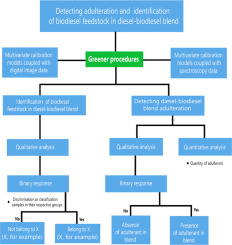Talanta ( IF 5.6 ) Pub Date : 2017-12-19 , DOI: 10.1016/j.talanta.2017.12.057 Sarmento Júnior Mazivila

|
Discrimination of biodiesel feedstock present in diesel-biodiesel blend is challenging due to the great similarity in the spectral profile as well as digital image profile of each type of feedstock employed in biodiesel production. Once the marketed diesel-biodiesel blend is subsidized, in which motivates adulteration in biofuel blend by cheaper supplies with high solubility to obtain profits associated with the subsidies involved in biodiesel production. Non-destructive analytical methods based on qualitative and quantitative analysis for detecting marketed diesel-biodiesel blend adulteration are reviewed. Therefore, at the end is discussed the advantage of the qualitative analysis over quantitative analysis, when the systems require immediate decisions such as to know if the marketed diesel-biodiesel blend is unadulterated or adulterated in order to aid the analyst in selecting the most appropriate green analytical procedure for detecting diesel-biodiesel blend adulteration proceeding in fast way. This critical review provides a brief review on the non-destructive analytical methods reported in scientific literature based on different first-order multivariate calibration models coupled with spectroscopy data and digital image data to identify the type of biodiesel feedstock present in diesel-biodiesel blend in order to meets the strategies adopted by European Commission Directive 2012/0288/EC as well as to monitoring diesel-biodiesel adulteration. According to that Directive, from 2020 biodiesel produced from first-generation feedstock, that is, oils employed in human food such as sunflower, soybean, rapeseed, palm oil, among other oils should not be subsidized. Therefore, those non-destructive analytical methods here reviewed are helpful for discrimination of biodiesel feedstock present in diesel-biodiesel blend according to European Commission Directive 2012/0288/EC as well as for detecting diesel-biodiesel blend adulteration.
中文翻译:

根据欧盟委员会指令2012/0288 / EC鉴定柴油-生物柴油混合物中生物柴油原料的无损分析方法的趋势以及检测柴油-生物柴油混合物掺假的趋势:简要回顾
由于生物柴油生产中使用的每种类型原料的光谱图和数字图像图谱非常相似,因此区分柴油-生物柴油混合物中存在的生物柴油原料具有挑战性。一旦对市场上出售的柴油-生物柴油混合物进行补贴,便可以通过廉价,高溶解度的供应来激发生物燃料混合物的掺假,从而获得与生物柴油生产所涉及的补贴相关的利润。综述了基于定性和定量分析的无损分析方法,用于检测市售的柴油-生物柴油混合掺假。因此,最后讨论了定性分析相对于定量分析的优势,当系统需要立即做出决定时,例如要了解市售的柴油-生物柴油混合物是否纯净或掺假,以帮助分析人员选择最合适的绿色分析程序来快速检测柴油-生物柴油混合物的掺假。这篇重要的评论简要回顾了科学文献中报告的非破坏性分析方法,该方法基于不同的一阶多元校准模型,结合光谱数据和数字图像数据,以鉴定柴油-生物柴油共混物中存在的生物柴油原料的类型,从而按顺序以符合欧盟委员会指令2012/0288 / EC所采用的策略,以及监测柴油-生物柴油的掺假。根据该指令,从2020年开始,使用第一代原料生产的生物柴油,即 用于人类食品的油,例如向日葵油,大豆油,菜籽油,棕榈油以及其他油,不应得到补贴。因此,根据欧洲委员会指令2012/0288 / EC,本文回顾的那些非破坏性分析方法有助于区分柴油-生物柴油混合物中存在的生物柴油原料,并有助于检测柴油-生物柴油混合物的掺假。









































 京公网安备 11010802027423号
京公网安备 11010802027423号